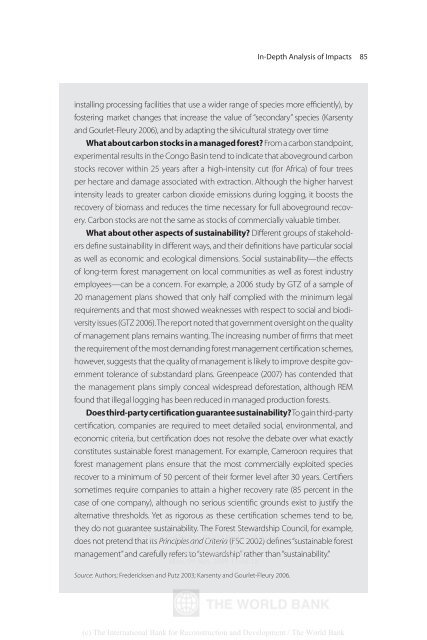The Rainforests of Cameroon - PROFOR
The Rainforests of Cameroon - PROFOR
The Rainforests of Cameroon - PROFOR
- No tags were found...
Create successful ePaper yourself
Turn your PDF publications into a flip-book with our unique Google optimized e-Paper software.
In-Depth Analysis <strong>of</strong> Impacts 85installing processing facilities that use a wider range <strong>of</strong> species more efficiently), byfostering market changes that increase the value <strong>of</strong> “secondary” species (Karsentyand Gourlet-Fleury 2006), and by adapting the silvicultural strategy over timeWhat about carbon stocks in a managed forest? From a carbon standpoint,experimental results in the Congo Basin tend to indicate that aboveground carbonstocks recover within 25 years after a high-intensity cut (for Africa) <strong>of</strong> four treesper hectare and damage associated with extraction. Although the higher harvestintensity leads to greater carbon dioxide emissions during logging, it boosts therecovery <strong>of</strong> biomass and reduces the time necessary for full aboveground recovery.Carbon stocks are not the same as stocks <strong>of</strong> commercially valuable timber.What about other aspects <strong>of</strong> sustainability? Different groups <strong>of</strong> stakeholdersdefine sustainability in different ways, and their definitions have particular socialas well as economic and ecological dimensions. Social sustainability—the effects<strong>of</strong> long-term forest management on local communities as well as forest industryemployees—can be a concern. For example, a 2006 study by GTZ <strong>of</strong> a sample <strong>of</strong>20 management plans showed that only half complied with the minimum legalrequirements and that most showed weaknesses with respect to social and biodiversityissues (GTZ 2006). <strong>The</strong> report noted that government oversight on the quality<strong>of</strong> management plans remains wanting. <strong>The</strong> increasing number <strong>of</strong> firms that meetthe requirement <strong>of</strong> the most demanding forest management certification schemes,however, suggests that the quality <strong>of</strong> management is likely to improve despite governmenttolerance <strong>of</strong> substandard plans. Greenpeace (2007) has contended thatthe management plans simply conceal widespread deforestation, although REMfound that illegal logging has been reduced in managed production forests.Does third-party certification guarantee sustainability? To gain third-partycertification, companies are required to meet detailed social, environmental, andeconomic criteria, but certification does not resolve the debate over what exactlyconstitutes sustainable forest management. For example, <strong>Cameroon</strong> requires thatforest management plans ensure that the most commercially exploited speciesrecover to a minimum <strong>of</strong> 50 percent <strong>of</strong> their former level after 30 years. Certifierssometimes require companies to attain a higher recovery rate (85 percent in thecase <strong>of</strong> one company), although no serious scientific grounds exist to justify thealternative thresholds. Yet as rigorous as these certification schemes tend to be,they do not guarantee sustainability. <strong>The</strong> Forest Stewardship Council, for example,does not pretend thatDeliveredits Principlesby <strong>The</strong>andWorldCriteriaBank(FSCe-library2002) definesto:“sustainable forest<strong>The</strong> World Bankmanagement” and carefully refers IP to : “stewardship” 192.86.100.34rather than “sustainability.”Mon, 09 Nov 2009 17:06:18Source: Authors; Fredericksen and Putz 2003; Karsenty and Gourlet-Fleury 2006.(c) <strong>The</strong> International Bank for Reconstruction and Development / <strong>The</strong> World Bank
















